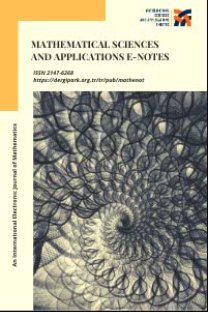Strong Independent Saturation in Complementary Prisms
___
- [1] Berberler, Z.N. and Berberler, M.E., Independence saturation in complementary product types of graphs, CBU J. of Sci., 13 (2017), no. 2, 325-331.
- [2] Bomze, I., Budinich, M., Pardalos, P. and Pelillo, M.,“The maximum clique problem,” in Du, D. and Pardalos, P. (eds), Handbook of Combinatorial Optimization, Supplement Volume A, Kluwer Academic Press, 1999.
- [3] Bondy, J. A. and Murty, U. S. R., Graph theory with applications, American Elsevier Publishing Co., Inc., New York, 1976.
- [4] Buckley, F. and Harary, F., Distance in Graphs, Addison-Wesley Publishing Company Advanced Book Program, Redwood City, CA, 1990.
- [5] Chartrand, G. and Lesniak, L., Graphs and Digraphs:, Fourth Edition, Chapman and Hall, London, 2005.
- [6] Haynes, T. W., Henning, M. A., Slater, P. J. and Van Der Merwe, L. C., The complementary product of two graphs, Bull. Instit. Combin. Appl., 51 (2007), 21-30.
- [7] Korshunov, A. D., Coefficient of internal stability of graphs, Cybernetics, 10(1974), no. 1, 19-33.
- [8] Meena, N., Subramanian, A. and Swaminathan, V., Strong efficient domination and strong independent saturation number of graphs, International Journal of Mathematics and Soft Computing, 3 (2013), no. 2, 41-48.
- [9] Sampathkumar, E. and Pushpa Latha, L., Strong weak domination and domination balance in a graph, Discrete Math., 161 (1996), 235-242.
- [10] West, D. B., Introduction to Graph Theory, Prentice Hall, NJ, 2001.
- ISSN: 2147-6268
- Yayın Aralığı: 4
- Başlangıç: 2013
- Yayıncı: -
Remarks on Some Inequalities for Analogues of the Polygamma Function
A Note on An Almost Contanct Metric Manifold with A Type of Semi-symmetric Non-metric Connection
Two New Distribution Families Constructed by a Modified Rank Transmutation
Mehmet YILMAZ, Sibel ACIK KEMALOĞLU
Ayşe ÇİÇEK, Sıddıka ÖZKALDI KARAKUŞ, Halit GÜNDOĞAN
Extended Bessel Matrix Functions
Mehmet YILMAZ, Sibel ACIK KEMALOĞLU
On the Some Properties of Circulant Matrices with Third Order Linear Recurrent Sequences
